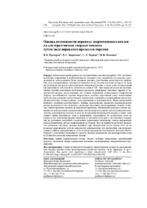| dc.contributor.author | Прохоров, В. Б. | |
| dc.contributor.author | Киричков, В. С. | |
| dc.contributor.author | Чернов, С. Л. | |
| dc.contributor.author | Фоменко, М. В. | |
| dc.coverage.spatial | Минск | ru |
| dc.date.accessioned | 2023-12-12T07:43:19Z | |
| dc.date.available | 2023-12-12T07:43:19Z | |
| dc.date.issued | 2023 | |
| dc.identifier.citation | Оценка возможности перевода энергетических котлов на альтернативные твердые топлива путем моделирования процессов горения = Assessment of the Possibility of Transition Power Boilers to Alternative Solid Fuels by Modeling Combustion Processes / В. Б. Прохоров [и др.] // Известия высших учебных заведений и энергетических объединений СНГ. Энергетика. – 2023. – № 6. – С. 536-551. | ru |
| dc.identifier.uri | https://rep.bntu.by/handle/data/138370 | |
| dc.description.abstract | В настоящее время переход на альтернативное топливо при работе ТЭС возникает вследствие сокращения и необеспеченности поставок угля, ухудшения его качества, предложений по использованию более дешевого топлива, ужесточения экологических требований. Под альтернативным топливом понимается уголь, на использование которого не были рассчитаны котлы при их проектировании или реконструкции, а также ранее не прошедший промышленного или опытного сжигания на данной ТЭС. При переводе котлов на альтернативные топлива основными проблемами являются: шлакование топочных экранов и поверхностей нагрева, расположенных над топкой; загрязнение конвективных поверхностей нагрева; неустойчивость горения непроектного топлива; абразивный износ конвективной части котлов; снижение экологических показателей; изменение условий работы систем пылеприготовления, шлакоудаления, золоулавливания и топливоподачи. Перед проведением опытного сжигания альтернативного топлива целесообразно проводить предварительную оценку возможности его сжигания с помощью численного моделирования, которое позволяет заблаговременно выявить возникающие проблемы. Важнейшим фактором оценки возможности использования альтернативных топлив является влияние теплотехнических показателей, характеристик топлива и золы на шлакование поверхностей нагрева в топке. Длительное время способность золы к шлакованию определялась по результатам теста на плавкость по изменению формы пирамиды из частичек золы при ее постепенном нагревании до различных состояний с выделением характерных температур: начала деформации, начала размягчения, начала жидкоплавкого состояния. Тест на плавкость не может предсказать реальную ситуацию, которая возникает при эксплуатации котла. Кроме того, он не позволяет ранжировать угли по склонности к шлакованию, что необходимо для предварительного выбора альтернативного угля, поэтому предложено использовать методику Ватта–Фарадея с уточнением Бомкампа по расчету индекса шлакования для ранжирования углей по годности в качестве непроектных топлив. | ru |
| dc.language.iso | ru | ru |
| dc.publisher | БНТУ | ru |
| dc.title | Оценка возможности перевода энергетических котлов на альтернативные твердые топлива путем моделирования процессов горения | ru |
| dc.title.alternative | Assessment of the Possibility of Transition Power Boilers to Alternative Solid Fuels by Modeling Combustion Processes | ru |
| dc.type | Article | ru |
| dc.identifier.doi | 10.21122/1029-7448-2023-66-6-536-551 | |
| local.description.annotation | Currently, the transition to alternative fuel during the operation of thermal power plants (TPP) occurs due to the reduction and unreliability of coal supplies, deterioration of its quality, proposals for the use of cheaper fuel, tightening environmental requirements. Alternative fuel means such coal, for the use of which the boilers have not been designed during their design or reconstruction, as well as coal that has not previously undergone industrial or experimental combustion at this TPP. When converting boilers to alternative fuels, the main problems are: slag of the furnace shields and heating surfaces located above the furnace; fouling of convective heating surfaces; instability of non-designed fuel combustion; abrasion of the convective part of boilers; reduction of environmental performance; change in operating conditions of dust preparation, slag removal, ash collection and fuel supply systems. Before conducting experimental combustion of alternative fuels, it is advisable to carry out a preliminary assessment of its combustion possibility using numerical simulation, which makes it possible to identify emerging problems in advance. The most important factor in assessing the possibility of using alternative fuels is the influence of thermal performance, fuel and ash characteristics on the slagging of heating surfaces in the furnace. For a long time, the ability of ash to slagging was determined by the results of a fusibility test by changing the shape of a pyramid of ash particles during its gradual heating to various states according to the specific temperatures, viz. the initial deformation temperature, the softening temperature, the hemispherical temperature. The fusibility test cannot predict the real situation that occurs during the boiler operation. In addition, it does not allow ranking coals according to their tendency to slagging, which is necessary for the preliminary selection of alternative coal. Therefore, it is proposed to use the Watt - Fereday method with Bomkamp’s refinement for calculating the slagging index for ranking coals according to suitability as non-design fuels. | ru |

